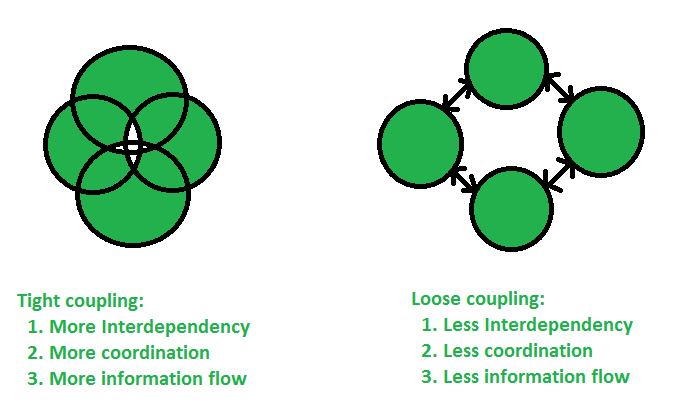Coupling
Coupling is the degree of interdependence between software modules; a measure of how closely connected two routines or modules are; the strength of the relationships between modules.
Coupling is usually contrasted with cohesion. Low coupling often correlates with high cohesion, and vice versa. Low coupling is often a sign of a well-structured computer system and a good design, and when combined with high cohesion, supports the general goals of high readability and maintainability.
There are two types of coupling:
- Tight coupling - When an object creates the object to be used, then it is a tight coupling situation. As the main object creates the object itself, this object can not be changed from outside world easily marked it as tightly coupled objects.
- Loose coupling - When an object gets the object to be used from the outside, then it is a loose coupling situation. As the main object is merely using the object, this object can be changed from the outside world easily marked it as loosely coupled objects.
Example
Tight Coupling
public class Tester {
public static void main(String args[]) {
A a = new A();
//a.display() will print A and B
//this implementation can not be changed dynamically
//being tight coupling
a.display();
}
}
class A {
B b;
public A() {
//b is tightly coupled to A
b = new B();
}
public void display() {
System.out.println("A");
b.display();
}
}
class B {
public B(){}
public void display() {
System.out.println("B");
}
}
Output:
A
B
Loose Coupling
import java.io.IOException;
public class Tester {
public static void main(String args[]) throws IOException {
Show b = new B();
Show c = new C();
A a = new A(b);
//a.display() will print A and B
a.display();
A a1 = new A(c);
//a.display() will print A and C
a1.display();
}
}
interface Show {
public void display();
}
class A {
Show s;
public A(Show s) {
//s is loosely coupled to A
this.s = s;
}
public void display() {
System.out.println("A");
s.display();
}
}
class B implements Show {
public B(){}
public void display() {
System.out.println("B");
}
}
class C implements Show {
public C(){}
public void display() {
System.out.println("C");
}
}
Output:
A
B
A
C
Using interfaces, we achieve the loose coupling by injecting the dependency.
Conclusion
In general, Tight Coupling is bad in but most of the time, because it reduces flexibility and re-usability of code, it makes changes much more difficult, it impedes test ability etc. loose coupling is a better choice because A loosely coupled will help you when your application need to change or grow. If you design with loosely coupled architecture, only a few parts of the application should be affected when requirements change.

- Tight coupling is not good at the test-ability. But loose coupling improves the test ability.
- Tight coupling does not provide the concept of interface. But loose coupling helps us follow the GOF principle of program to interfaces, not implementations.
- In Tight coupling, it is not easy to swap the codes between two classes. But it’s much easier to swap other pieces of code/modules/objects/components in loose coupling.
- Tight coupling does not have the changing capability. But loose coupling is highly changeable.
- A change in one module usually forces a ripple effect of changes in other modules.
- Assembly of modules might require more effort and/or time due to the increased inter-module dependency.
- A particular module might be harder to reuse and/or test because dependent modules must be included.
Links
https://en.wikipedia.org/wiki/Coupling_(computer_programming)
https://www.tutorialspoint.com/Coupling-in-Java
https://www.geeksforgeeks.org/coupling-in-java/
 Opps - cohesion
Opps - cohesion